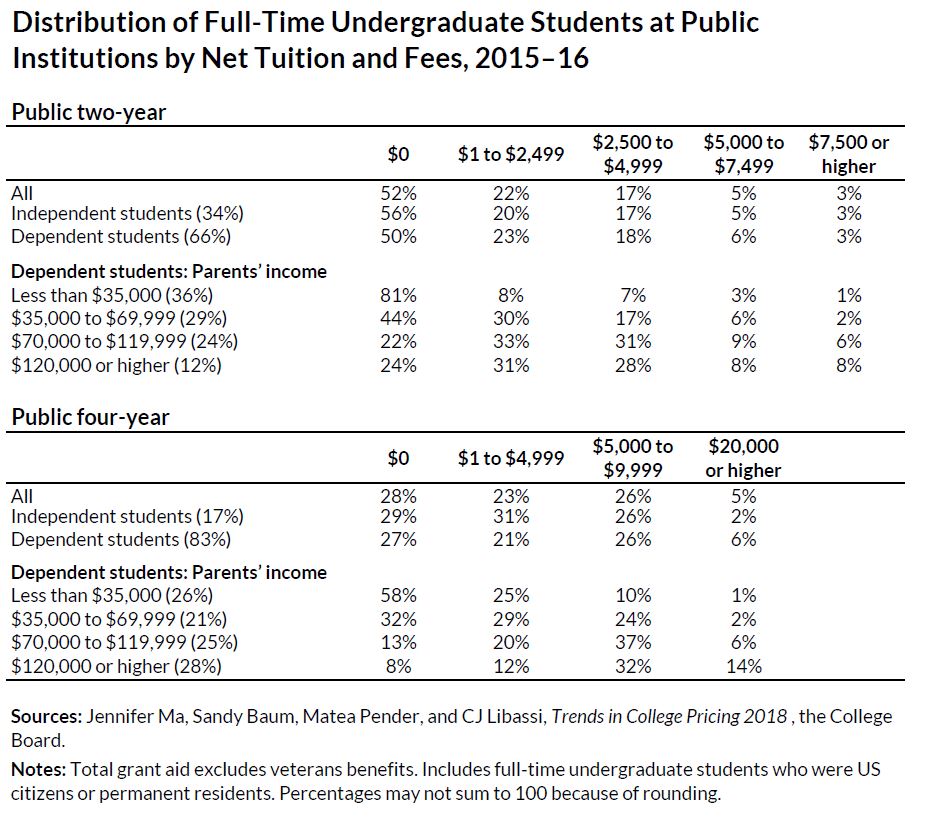
<p>Illustration by MCKIBILLO via Getty Images.</p>
Sarah Turner contributed to this post.
Sen. Elizabeth Warren’s (D-MA) ambitious student loan forgiveness plan has gathered a lot of attention, proposing to forgive an estimated 66 percent of all outstanding student debt. But the “free college” portion of Warren’s proposal also deserves attention. Her plan and other variants of free college could, like the loan forgiveness proposal, result in disproportionate benefits to high-income families.
To understand who would benefit from plans to make college tuition free, we can start by looking at how much students pay for college now. Though all students at a particular university face the same sticker price, that does not mean all students pay the same amount.
Aside from the fact that they enroll in different institutions with different prices, students at each college receive varying amounts of grant aid, whether it’s from the federal Pell grant program, state, institutional, or other sources, leading to differences in the net price they are actually expected to pay.
At both two- and four-year public colleges, students at the upper end of the income scale pay higher net prices than their low-income peers. In fact, 81 percent of the lowest-income students at two-year colleges (those from families earning less than $35,000 a year) already pay nothing to attend, and 58 percent of students from that same income quartile at four-year colleges attend for free. (This does, of course, only consider tuition and fees—students could still be paying for living expenses and other costs associated with going to college.)

Because low-income students already pay less, the subsidy they would receive through a “free college” program that fills in the gaps between published tuition and fees and existing grant aid is smaller. The average full-time student from a family earning less than $35,000 pays $580 a year to attend a two-year college, while a student from a family earning more than $120,000 pays $2,870 for the same education. Erasing this cost would mean giving $2,870 to the high-income family and only $580 to the low-income family.
It’s also important to consider where students enroll. Low-income dependent students and independent students are much more likely than their more affluent peers to attend two-year community colleges rather than four-year universities. Though 87 percent of high-income students attend four-year institutions, only 67 percent of students in the bottom two income groups are enrolled at four-year institutions.
And of course, the annual price tag of a four-year education is higher than the cost of a two-year education. So if current enrollment patterns hold, high-income families will receive an even larger benefit. Additionally, students pursuing bachelor’s degrees will receive this subsidy for four or five years, whereas those stopping with associate degrees will be subsidized for only two or three years. (Of course, it’s likely enrollment trends would shift, but it’s hard to predict how student decisionmaking would change.)
To provide a back-of-the-envelope estimate of the overall cost of “free college” to taxpayers, we multiply the number of full-time students in each income-college category by the average net prices. This produces a total expected cost of about $21 billion, again concentrated among high-income families whose students attend four-year colleges. Covering part-time students would significantly increase the cost—and draw in more community college, older, and lower-income students.

More affluent students get the largest shares both because they are more likely to be in four-year rather than two-year schools and because they pay higher net prices at those schools.
Sen. Warren’s plan would allow the lowest-income students to use Pell grants to cover living expenses, which would redistribute some of the benefit toward the lower end of the income scale. But the cost of two-year tuition plus a Pell grant is still less than the average subsidy the highest-income four-year students would receive.
Making college more accessible to those who cannot afford it is a noble goal. But making public college free for everyone could mean subsidizing the education of many who could afford to pay, instead of addressing the additional financing gaps facing both low- and moderate-income students and the institutions in which most of them are enrolled.
Let’s build a future where everyone, everywhere has the opportunity and power to thrive
Urban is more determined than ever to partner with changemakers to unlock opportunities that give people across the country a fair shot at reaching their fullest potential. Invest in Urban to power this type of work.